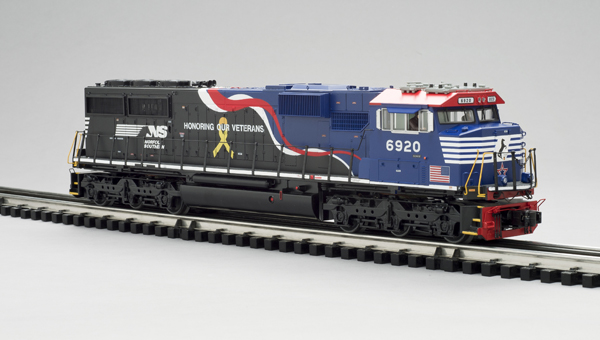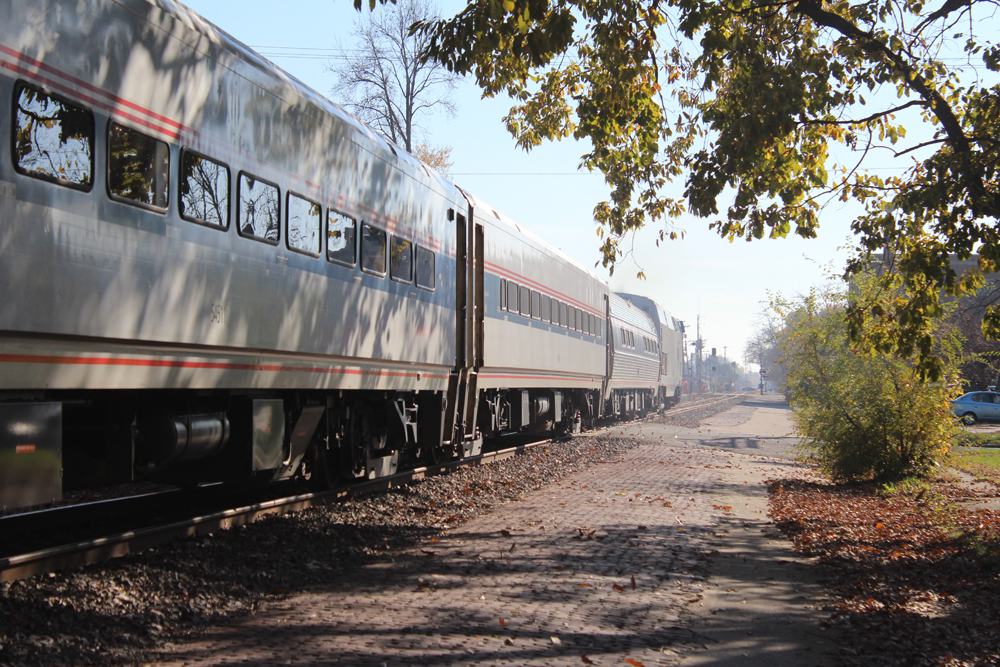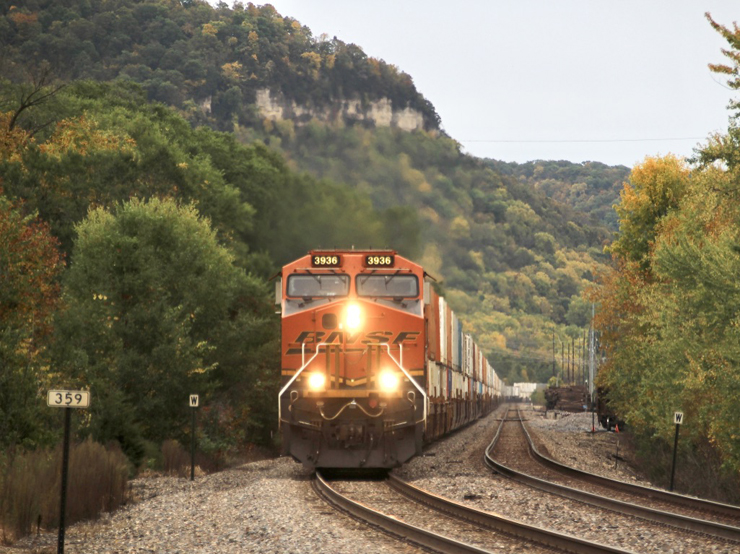Price: $499.95 (no. 20-20594-2) Min Curve: O-42 Cmd Low: 5.9 smph Cnv Low: 6.8 smph High: 71.9 smph Drawbar pull: 1 lb., 9.6 oz. Features: Two can-style motors, ProtoSound 3.0 command and sound system, smoke unit, coil couplers Current production road name: Norfolk Southern
In 2012 the NS decided to salute America’s veterans with a uniquely designed paint scheme applied to SD60E no. 6920. The project was intended to “honor people
who had served in the military and reserves, especially those employed by the railroad.” At the time, 14 percent of the railroad’s workers were veterans.
The locomotive and its patriotic scheme operated throughout the eastern half of the United States. The special diesel might be seen beyond, depending on power swaps with other lines.
The unique decoration combined patriotic colors with the standard NS black and logo on half the body. Intertwined red and white streamers broke the flow of the black and transitioned the body forward to blue. The cab roof and front pilot were red, and the nose striping was white. The yellow ribbon logo and the words, “Honoring veterans,” were a little behind the center of the body. All painting and decoration on our O gauge version were superbly executed, especially the smaller placards on the body.
The SD60E
If the designation SD60E is unfamiliar, don’t worry. It is, thus far, exclusive to the Norfolk Southern, which has taken previously purchased SD60 diesels and rebuilt them with a Norfolk Southern-designed “Crescent” wide-body cab and upgraded electronics, boosting power from 3,800 to 4,000 horsepower. Since 2010 more than 130 diesels have been rebuilt.
This O gauge model from MTH Electric Trains is one of those rare diesels with such an astonishing number of detail points it rivals a steam locomotive for “things to look at.”
The pilot is painted red, and you’ll find a red uncoupler arm resting atop the coupler. The pilot has six multiple-unit/air lines, three on each side of the coupler. You’ll also find two steps cast into the pilot next to each group of cables. The black steps are accented with yellow to match the yellow handrails crew members use to hoist themselves aboard. The deck has safety tread texture, and two ditch lights are affixed to the deck.
The low hood looks a bit boxier than is typical of many modern locomotives. A door is mounted in the center of the nose, and you’ll find sand filler caps on the corners. On the front are steps/grab irons, and several more are on top of the hood.
The cab has front and rear side mirrors, and you’ll find plastic windows in the panes. Sunshades are mounted above the side windows. The front windows have twin wiper arms. The roof overhangs the front of the forward windows, and there are two lights as well as illuminated number boards. Just up and above the number boards are grab irons.
There are two crew figures inside the cab. The cab’s standout features, though, are the curious gray slabs on top. Each has its own set of four lift rings, some knobs, and what appear to be radio antennas. These are the locomotive’s Positive Train Control (PTC) antenna array, reflecting a recently enacted federal safety requirement intended to prevent train-to-train accidents. Wouldn’t surprise me if some clever Johnnie began to produce retrofit kits for older locomotives.
Following the roofline behind the cab, you’ll find a see-through screen with fan blades. There are spots for a crane to lift this section. Right behind this are two solid screens that bulge out at the sides. Three lift rings are on top of this section. The exhaust (smoke unit) is just beyond that point. You’ll then encounter the horn and three more fan housings. Below them, on the sides, are two see-through screens on each side.
The side detailing is nice. The doors, latches, and hinge detail are raised enough to easily feel with your finger. While the body has a busy livery, it is accented with a large number of safety tags.
The end of the long hood has grab irons going to the top of the hood. There is a sand filler cap up top, and V-shaped grab irons for use by the hostler pouring the sand. On the rear deck ditch lights configured similar to the front pilot.
The die-cast metal fuel tank has red accented caps and a sight gauge, and the die-cast metal trucks are beautifully cast. The speaker is housed in the fuel tank.
The Norfolk Southern SD60E with its Crescent cab (and PTC antennas) is a good-looking O gauge locomotive that has some interesting angles and nice detail points. The salute to veterans on the carbody is a bonus. This MTH diesel will look great on the point of a military train, regardless of the era of the train.
On the test track
On starting up, the model has a deep, throaty sound. The horn sounds good, and the bell is suitably clangy!
The locomotive was smooth in all speed ranges, and I’d use the word “glide” to describe low-speed operation. The only thing missing when it rolled past me was the hefty ker-thunk of steel wheels joining over a rail joint.
Our command-mode low-speed average was 5.9 scale mph, while the conventional low speed was 6.8 scale mph. Our high-speed average was 71.9 scale mph.
Drawbar pull was 1 pound, 9.6 ounces.
The Norfolk Southern’s livery is a nice way for it to honor American veterans, and the paint scheme is as distinctive as the carrier has fielded. But we don’t buy our locomotives just to look at; we buy them to pull trains, and having a fun sound package is a great plus. The Norfolk Southern SD60E from MTH will be a fine addition to any fleet of O gauge modern power.














